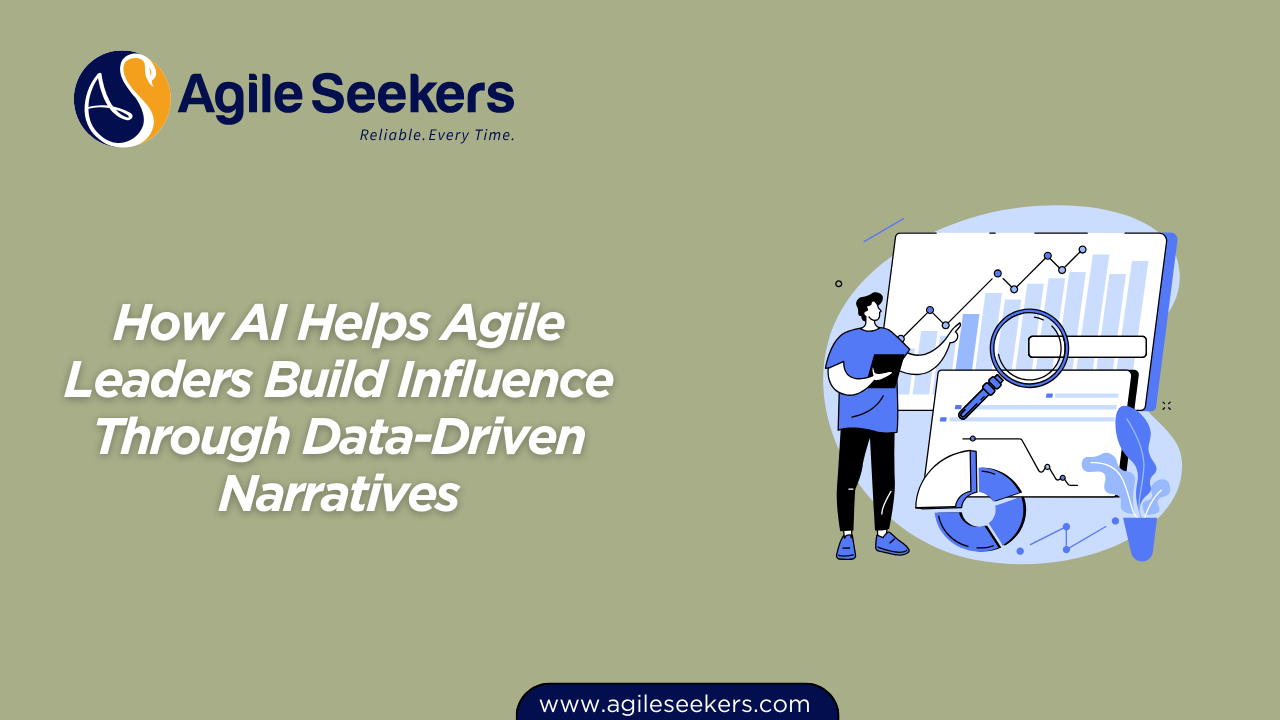How AI Helps Agile Leaders Build Influence Through Data-Driven Narratives

Influence is one of the most powerful tools an Agile leader can develop. Unlike authority, which depends on hierarchy, influence comes from trust, credibility, and the ability to move people with compelling stories. The challenge is that influence isn’t just about what you say—it’s about how effectively you connect data, context, and vision. This is where artificial intelligence changes the game.
AI equips Agile leaders with sharper insights, richer context, and stronger narratives that resonate with stakeholders. By turning raw data into meaningful stories, leaders can inspire action, align teams, and secure buy-in for strategic initiatives.
Let’s break down how AI helps Agile leaders build influence through data-driven storytelling.
Why Influence Matters More Than Authority
Agile leaders often operate in environments where they don’t have absolute control over outcomes. Instead, they must align cross-functional teams, guide product direction, and gain stakeholder trust. Influence—not command—is what drives sustainable change.
Here’s the thing: people don’t rally behind numbers alone. They rally behind narratives that show why those numbers matter. Data creates credibility, but stories create movement. An Agile leader who combines both earns a seat at every important table.
AI as a Narrative Enabler
Traditionally, leaders have relied on dashboards, reports, or manual analysis to explain performance. That approach often drowns stakeholders in numbers without context. AI steps in by:
-
Identifying patterns faster: Machine learning detects correlations and anomalies that humans might miss.
-
Turning raw data into visual insights: AI-powered tools translate complex metrics into easy-to-digest visuals.
-
Highlighting cause and effect: Predictive analytics shows how current decisions may play out in the future.
The result? Leaders aren’t just reporting—they’re guiding with clarity.
For example, instead of saying, “Our velocity dropped by 15% this sprint,” an AI-supported narrative might explain, “AI analysis shows a velocity drop due to unplanned work, but predicts recovery if we prioritize backlog grooming next sprint.” That’s the difference between reporting and influencing.
Crafting Data-Driven Narratives With AI
Influence grows when data is framed in a way that connects with people. Here’s how AI strengthens each step of the storytelling process:
1. Collecting Relevant Signals
Agile leaders juggle inputs from sprint reports, customer feedback, employee surveys, and business outcomes. AI integrates these streams and filters noise, surfacing the signals that actually matter.
2. Finding the Story in the Data
A list of metrics doesn’t inspire anyone. AI highlights relationships: how team morale impacts cycle time, or how deployment frequency correlates with customer satisfaction. Leaders can then craft a storyline that ties people’s work to business value.
3. Personalizing the Message
Executives want to hear about ROI. Teams want to hear about reduced blockers. Customers want to hear about faster delivery. AI helps leaders tailor the same dataset into different stories that resonate with each audience.
4. Supporting Decisions With Predictive Insight
Influence often comes down to shaping the future. With AI models that forecast risks and opportunities, Agile leaders can present not just what’s happening, but what’s likely to happen—and how to respond.
Practical Examples of AI-Driven Influence
Data That Speaks in Retrospectives
Scrum Masters can use AI-powered sprint analytics to highlight recurring blockers, transforming retrospectives from opinion-driven debates into action-oriented discussions. This supports influence by grounding dialogue in facts.
(See: AI for Scrum Masters Training)
Business Cases Backed by Evidence
Product Owners can use AI-driven customer sentiment analysis to show why a feature deserves priority, turning stakeholder skepticism into support.
(See: AI for Product Owners Certification Training)
Strategy Framed in Predictive Context
Project Managers can apply AI forecasting models to demonstrate how resource allocation decisions today influence delivery in the next quarter. That’s not just reporting—that’s guiding the business.
(See: AI for Project Managers Certification Training)
Inspiring Change With Confidence
Leaders and change agents can frame transformation stories with AI-backed evidence—showing not just why change is needed, but also how it will create measurable value. Influence comes naturally when stakeholders see both urgency and opportunity.
(See: AI for Agile Leaders & Change Agents Certification)
Balancing Data and Humanity
AI enhances influence, but it doesn’t replace empathy. Data-driven narratives work only when leaders also understand the human side:
-
A chart might show efficiency gains, but people want to hear how that translates to less stress at work.
-
A forecast might predict market share growth, but customers want to hear how it improves their experience.
Influence lies at the intersection of credibility (data) and connection (human story). AI strengthens credibility; leaders must bring the connection.
External Validation: Why Data-Driven Stories Win Trust
Research in behavioral science shows that stories make data 22 times more memorable. Harvard Business Review has written extensively on how leaders who blend numbers with narratives create stronger emotional impact than those who rely on data alone. When AI arms leaders with both credibility and context, their influence multiplies.
(Reference: Harvard Business Review on Storytelling in Leadership)
Key Takeaways for Agile Leaders
-
Influence is earned, not demanded, and AI accelerates that process.
-
Data without story is noise; story without data is fragile. The combination is power.
-
AI equips leaders with predictive insight, credibility, and the ability to adapt messages for different audiences.
-
Agile leaders who master data-driven storytelling don’t just guide teams—they shape strategy and culture.
Final Word
Agile leaders who embrace AI don’t just analyze; they influence. They move from explaining the past to shaping the future. They don’t overwhelm with metrics—they inspire with meaning. That’s how data-driven narratives, powered by AI, become the foundation of lasting leadership influence.
Also read - Measuring Agile Maturity with AI-Powered Metrics Dashboards
Also see - The Role Of AI In Anticipating Organizational Resistance To Change




















